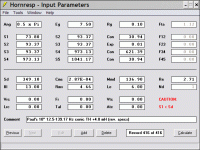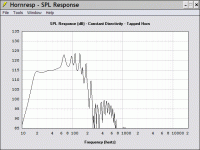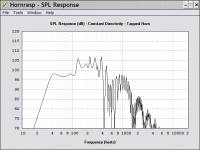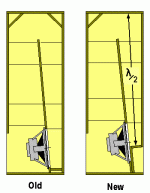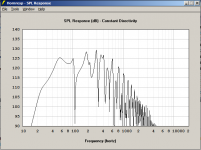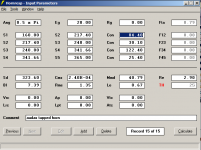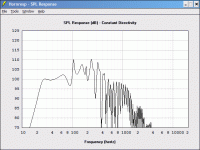Getting back to what I was saying about dealing with the first large peak in response. Below are the insides of the DTS-20 taken from the international patent.

While not everything is to scale, it is easy enough to figure out from the mouth to the first bend is 86.5 inches. This works out to 1/2 WL at 78Hz. The next thing I did is model the DTS-20 in Hornresp using a Lab12 woofer. I know the Lab12 is not the same woofer Danley uses, but it should be good enough for our purposes. Here is what the response of the model looks like.

Well, look at that! It appears that I was correct in assuming Tom uses the folding length to attenuate that peak at 78Hz. I can also assume that the 5mH inductor helps bring down the next peak as well.

While not everything is to scale, it is easy enough to figure out from the mouth to the first bend is 86.5 inches. This works out to 1/2 WL at 78Hz. The next thing I did is model the DTS-20 in Hornresp using a Lab12 woofer. I know the Lab12 is not the same woofer Danley uses, but it should be good enough for our purposes. Here is what the response of the model looks like.

Well, look at that! It appears that I was correct in assuming Tom uses the folding length to attenuate that peak at 78Hz. I can also assume that the 5mH inductor helps bring down the next peak as well.
aceinc said:
OK I did a bit more research on the driver and this is what I have come up with;
My intention is to not limit the size of the enclosure, my goal is to acheive the lowest loudest bass possible with these drivers. I do not need to worry about midbass or anything above 60hz for that matter.
Well, just running the numbers to put the first peak above 60 Hz yields ~317.1 L. With a low Xmax, only 14 W is required to hit DD/DTS reference if corner loaded and the room's well constructed. If you prefer to build one big one instead of two semi-big ones, then just double up the pipe area all along its length.
BTW, for my records, what brand/model driver is this?
GM
Attachments
JLH said:
If you make at least one length of the tapped horn 1/2 WL at the frequency of that peak, it will be acoustically reduced by a fair margin.
I think it does help as you say - at least the PD1550 TH mentioned above seems to show less output around 80-100Hz than I'd feared. It is very hard to measure though, due to room interactions (hence I did not post results that far up).
Ken
I am somewhat embarassed, but the drivers in question are Sony xplod XS-L1036 car subs. I bought them a number of years ago to play with various enclosure designs. They were cheap and seemed reasonable at the time.
I actually built the Decware "Wicked One" with these drivers and it performed fairly well in my living room.
Paul
I actually built the Decware "Wicked One" with these drivers and it performed fairly well in my living room.
Paul
Thanks! FYI, car audio woofer and 'sub' drivers are typically much better suited for LF/sub horn loading due to their relatively high Fs (for the desired BW), low Vas, massive diaphragms and the powerful motors required to drive them.
Horn loading 'HIFI' drivers are for apps that require wide BW, ergo essentially waveguides to control directivity since you don't want any real compression loading like with the lowest octaves.
GM
Horn loading 'HIFI' drivers are for apps that require wide BW, ergo essentially waveguides to control directivity since you don't want any real compression loading like with the lowest octaves.
GM
Post #1537: L23 taper
MikeHunt79: Hi again, in Post #1537 you ask: "...is there a way of calculating or finding the best taper or angle for the horn path of L23?"
I don't know of another way of arriving at an optimum expansion rate than to use a modeling software like Hornresp or AkAbak. For a first try it seems to work to make S1 1/3 to 1/2 of SD and to make S5 3 times S1 and to go on from there. It obviously makes a big difference what type of response you are going for (maximum lows require longer horn path length, etc.).
The new 4 horn section Hornresp gives you another variable (horn section) to play with. You could try setting all section lengths to EXP and then raising the flare rate (frequency) as you go along (even if you ultimately will be building conical sections), e.g.: L12=8Hz/L23=9Hz/L34=11Hz/L45=17Hz; anyway the combinations are almost endless.
MikeHunt79: Hi again, in Post #1537 you ask: "...is there a way of calculating or finding the best taper or angle for the horn path of L23?"
I don't know of another way of arriving at an optimum expansion rate than to use a modeling software like Hornresp or AkAbak. For a first try it seems to work to make S1 1/3 to 1/2 of SD and to make S5 3 times S1 and to go on from there. It obviously makes a big difference what type of response you are going for (maximum lows require longer horn path length, etc.).
The new 4 horn section Hornresp gives you another variable (horn section) to play with. You could try setting all section lengths to EXP and then raising the flare rate (frequency) as you go along (even if you ultimately will be building conical sections), e.g.: L12=8Hz/L23=9Hz/L34=11Hz/L45=17Hz; anyway the combinations are almost endless.
GM said:...since you don't want any real compression loading like with the lowest octaves.
Hi GM, would you be so kind and elaborate on this topic? What is "real compression loading" and is there a difference between it and having a compression factor of around 3 in your TH?
hi GM - do I have Cowan's simple one-fold diagram A4 labeled correctly? - I'd like to keep 4012HO in this size
http://img224.imageshack.us/img224/644/30hzdia1brb3.gif
also I'd like to know if theres cheaper woofer in US to fit this bulk package
http://img224.imageshack.us/img224/644/30hzdia1brb3.gif
also I'd like to know if theres cheaper woofer in US to fit this bulk package
aceinc said:I have not read all of this thread, so this may have been discussed, and discarded, but here goes.
<Half Baked Idea>
One of the problem that seems to be causing the most grief with the TH is the high freq ripple. Could part of the solution be to mate a bandpass with the throat of the horn?
My thought would be instead of firing the driver directly into the throat, have it fire into a chamber that is ported into the throat. This is sort of the idea of the Decware "Wicked One", but that doesn't use the back wave of the driver, ie it's a 4th order bandpass horn.
My reasoning is that bandpass enclosures have a tendency to sharply attenuate the high & low end of the spectrum, and it might act as a natural low pass filter.
</Half Baked Idea>
I can see a lot of obstacles trying to design such a beast, in that I can't imagine any off the shelf software being up to the task, and it adds a whole new set of variables to the equation.
Paul
A couple of people have tried this, most notably Bose. A design like this was used for the Bose acoustimass sub for years. I think Danley's method is superior for a couple of reasons.
First, the big problem with the Bose design is that it requires a ginormous port. The port they used is something like six inches in diameter, with a five inch driver! So doing the same thing with a twelve inch driver would require an insanely large port. If you don't use a huge port, you're going to reduce efficiency of the design.
Second, dual reflex bandpass boxes are a complete nightmare. They are SO difficult to get right. The Bose design is basically a triple reflex bandpass; it's a dual reflex bandpass filtered by a third chamber.
Bose has one thing going for them tho, which is that they have the resources to get all the variables perfect. This includes tuning all three chambers, dealing with the crossover, etc. With a design this complex you really have to consider how the driver parameters change once everything is put together.
Check out this patent: http://www.google.com/patents?id=NK...507Lbfa&sig=wC6Ef20egaEc1P47ZghfmsASmPo&hl=en
Re: Post #1537: L23 taper

Again, excellent info, thanks. I'll have a go at doing something with some of those 8" tang band drivers once I get the Eminence Mag12 box built.tb46 said:MikeHunt79: Hi again, in Post #1537 you ask: "...is there a way of calculating or finding the best taper or angle for the horn path of L23?"
I don't know of another way of arriving at an optimum expansion rate than to use a modeling software like Hornresp or AkAbak. For a first try it seems to work to make S1 1/3 to 1/2 of SD and to make S5 3 times S1 and to go on from there. It obviously makes a big difference what type of response you are going for (maximum lows require longer horn path length, etc.).
MaVo said:
What is "real compression loading"..........
Greets!
Well, I was referring to constricted throats with the appropriate rear chamber loading to balance the air load on both sides of the driver and/or long, slow expanding horns in general since either causes what many consider unacceptable audible distortion.
WRT the simple TH designs being done here, even though there's no well defined constricted throat nor balanced rear loading over a wide BW, one can't argue with the witnessed low excursions within its passband, so yes, they have some 'real compression loading', especially the larger ones with their higher air mass loading on the backside of the driver.
GM
freddi said:hi GM - do I have Cowan's simple one-fold diagram A4 labeled correctly? - I'd like to keep 4012HO in this size
http://img224.imageshack.us/img224/644/30hzdia1brb3.gif
also I'd like to know if theres cheaper woofer in US to fit this bulk package
Hey Freddy,
If the mouth is on the end rather than the side, then yes, though as long as the driver is near/at the end then the 15 cm reflection back to the opening just affects the HF harmonics which of course the XO will deal with.
What we can't calc though is the fact that the area 'A4' is considerably larger than the actual cutout, though from WC's measurements I assume the driver's bulk reduces the effective 'A4' area to something 'close enough' to the cutout's.
I haven't made any attempt to see if there's a simple formula for choosing a driver for a given bulk, but did a quick search of the TH's I'd simmed and the only 12" I found that was a 'drop in' is the Eminence Magnum Pro 12HO assuming the driver is located at the extreme ends.
GM
Attachments
Thanks, JLH !!! After reading your last couple of posts, I modified my design, and will include your trap for that first peak (139 Hz) above bandpass in my next build.
I'm quite happy with the sound of the TH I've built, and I've remixed some canned music to try (SuperTramp sounds great xover at 100Hz). Inside, everything just starts buzzing, but outside, it sounds great. Running tones thru the system is less impressive, as my SPL meter shows down 10db at 32 Hz. HornResp shows a 2db peak at 40, but the meter shows down 2db.
I need to find someplace where I can put more than 75 watts thru this thing. There's lots-o-desert, but finding power out there is hard.
I'm quite happy with the sound of the TH I've built, and I've remixed some canned music to try (SuperTramp sounds great xover at 100Hz). Inside, everything just starts buzzing, but outside, it sounds great. Running tones thru the system is less impressive, as my SPL meter shows down 10db at 32 Hz. HornResp shows a 2db peak at 40, but the meter shows down 2db.
I need to find someplace where I can put more than 75 watts thru this thing. There's lots-o-desert, but finding power out there is hard.
Attachments
$56 tapped horn
Here's a tapped horn design using two of the Audax woofers on sale at P.E. for $28.
I already purchased two of these for another project, and they're great drivers for the money.
The response falls off dramatically around 50hz, but I did this on purpose. It's designed to be used in a car, where cabin gain will fill in everything below 60hz.
See attached.
Here's a tapped horn design using two of the Audax woofers on sale at P.E. for $28.
I already purchased two of these for another project, and they're great drivers for the money.
The response falls off dramatically around 50hz, but I did this on purpose. It's designed to be used in a car, where cabin gain will fill in everything below 60hz.
See attached.
Attachments
Re: $56 tapped horn
Here's the dimensions. The driver is an Audax ht240g0.
Note there are TWO woofers in the horn. That's why L34 is so long. You can get flatter response if L34 is shorter, but it has to be a minimum of 25cm to fit both drivers.
Patrick Bateman said:Here's a tapped horn design using two of the Audax woofers on sale at P.E. for $28.
I already purchased two of these for another project, and they're great drivers for the money.
The response falls off dramatically around 50hz, but I did this on purpose. It's designed to be used in a car, where cabin gain will fill in everything below 60hz.
See attached.
Here's the dimensions. The driver is an Audax ht240g0.
Note there are TWO woofers in the horn. That's why L34 is so long. You can get flatter response if L34 is shorter, but it has to be a minimum of 25cm to fit both drivers.
Attachments
JLH said:Getting back to what I was saying about dealing with the first large peak in response. Below are the insides of the DTS-20 taken from the international patent.

While not everything is to scale, it is easy enough to figure out from the mouth to the first bend is 86.5 inches. This works out to 1/2 WL at 78Hz. The next thing I did is model the DTS-20 in Hornresp using a Lab12 woofer. I know the Lab12 is not the same woofer Danley uses, but it should be good enough for our purposes. Here is what the response of the model looks like.

Well, look at that! It appears that I was correct in assuming Tom uses the folding length to attenuate that peak at 78Hz. I can also assume that the 5mH inductor helps bring down the next peak as well.
A single WL/2 resonator probably isn't enough to bring down such a high peak, but of course the DTS-20 has two of these resonant sections in series -- the one from the top to the mouth, but also the one before this from the bottom to the top.
The 5mH inductor won't have that much effect on the next peaks, but maybe these are taken out by the WL/4 pipe resonators (not in the patent, but shown on earlier photos of the internals) -- has anyone measured the length of these to see what the resonant frequencies are?
So maybe it is possible to largely eliminate the tapped horn peaks by purely acoustical means, but the design is now getting more and more complicated with more and more trial and error likely to be needed for this to work -- which I guess is where Tom's expertise lies...
Ian
could u put this into a tapped horn, or maybe u could fit 2, lol
http://www.bmm-electronics.com/Product.asp?Product_ID=5677
http://www.bmm-electronics.com/Product.asp?Product_ID=5677
Naudio said:could u put this into a tapped horn, or maybe u could fit 2, lol
http://www.bmm-electronics.com/Product.asp?Product_ID=5677
You could, but why would you want to?
(performance vs. price is lousy compared to conventional drivers)
Ian
I was just wondering if this graph is simmed with 1 x pi? Could you post your parameters as I got a totally different result when I tried a Mag 12HO in William Cowan's 30Hz TH...GM said:I haven't made any attempt to see if there's a simple formula for choosing a driver for a given bulk, but did a quick search of the TH's I'd simmed and the only 12" I found that was a 'drop in' is the Eminence Magnum Pro 12HO assuming the driver is located at the extreme ends.
Attachments
- Home
- Loudspeakers
- Subwoofers
- Collaborative Tapped horn project
